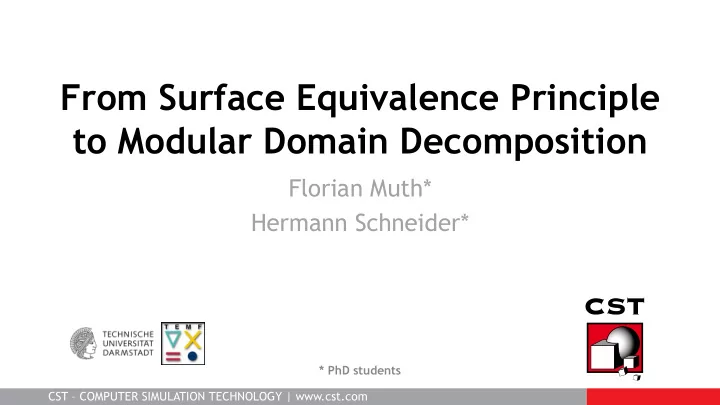

From Surface Equivalence Principle to Modular Domain Decomposition Florian Muth* Hermann Schneider* * PhD students CST – COMPUTER SIMULATION TECHNOLOGY | www.cst.com
Motivation I Challenge: complex/large models Multiple scales Different electromagnetic properties Full set of M AXWELL ’s equations E.g.: 1.5 GHz GPS antenna ≈ 𝟕𝟔𝟏𝝁 ⇒ 𝟐𝟏 𝟐𝟑 mesh cells (10 lines per wavelength) CST – COMPUTER SIMULATION TECHNOLOGY | www.cst.com 2
Motivation II Approach: domain decomposition Tightly coupled subdomains, full system solve necessary global iterative solver Couple existing solvers → modular, black box framework arbitrary solvers Coupling via surface currents Global I terative Solver Asymptotic Integration in commercial software BEM FEM CST – COMPUTER SIMULATION TECHNOLOGY | www.cst.com 3
Outline Motivation Surface Equivalence Principle Iterative Domain Decomposition First Results Conclusion and Outlook CST – COMPUTER SIMULATION TECHNOLOGY | www.cst.com 4
Surface Equivalence Principle I Sources and materials enclosed by surface 𝑇 can be replaced by equivalent surface currents 𝐾 𝑡 and 𝑁 𝑡 : Full model Equivalent model for outer domain CST – COMPUTER SIMULATION TECHNOLOGY | www.cst.com 5
Surface Equivalence Principle I Sources and materials enclosed by surface 𝑇 can be replaced by equivalent surface currents 𝐾 𝑡 and 𝑁 𝑡 : Full model Equivalent model for inner domain CST – COMPUTER SIMULATION TECHNOLOGY | www.cst.com 6
Surface Equivalence Principle I Sources and materials enclosed by surface 𝑇 can be replaced by equivalent surface currents 𝐾 𝑡 and 𝑁 𝑡 : full outer inner model equivalent equivalent CST – COMPUTER SIMULATION TECHNOLOGY | www.cst.com 7
Surface Equivalence Principle II Will be utilized for black box DD approach Coupling of subdomains via surface currents Subdomains need to provide surface currents only Resulting in an iterative DD method CST – COMPUTER SIMULATION TECHNOLOGY | www.cst.com 8
Outline Motivation Surface Equivalence Principle Iterative Domain Decomposition First Results Conclusion and Outlook CST – COMPUTER SIMULATION TECHNOLOGY | www.cst.com 9
Iterative Domain Decomposition Typical Coupled System CST – COMPUTER SIMULATION TECHNOLOGY | www.cst.com 10
Iterative Domain Decomposition Coupled System + Surface Equivalence Principle source monitor monitor source CST – COMPUTER SIMULATION TECHNOLOGY | www.cst.com 11
Iterative Domain Decomposition Equivalence Principle Motivated Approach source monitor solve solve GMRES Resulting system solved for surface quantities 𝑦 1 and 𝑦 2 , e.g. by fixpoint iteration or accelerated by GMRES CST – COMPUTER SIMULATION TECHNOLOGY | www.cst.com 12
Outline Motivation Surface Equivalence Principle Iterative Domain Decomposition First Results Conclusion and Outlook CST – COMPUTER SIMULATION TECHNOLOGY | www.cst.com 13
First Results Area of application of this project Small number of user-defined, coupled subdomains Priority not on scalability, but flexibility E.g. antenna placement Model: 1x2 patch antenna array Academic example For investigation purposes ≈ 2𝜇 CST – COMPUTER SIMULATION TECHNOLOGY | www.cst.com 14
First Results Setup FEM-FEM coupling Non-overlapping subdomains Air buffer Coupling (wireframe) interface ABC A bsorbing B oundary C ondition Broadside radiation Non-conforming mesh at interface Domain 2 Domain 1 CST – COMPUTER SIMULATION TECHNOLOGY | www.cst.com 15
First Results E-Field on 1D-Curve X Interface CST – COMPUTER SIMULATION TECHNOLOGY | www.cst.com 16
First Results Far Field Full model: DD approach: CST – COMPUTER SIMULATION TECHNOLOGY | www.cst.com 17
First Results GMRES Residual Convergence Norm based on physical quantities Independent of basis functions Support of different types of electromagnetic solvers CST – COMPUTER SIMULATION TECHNOLOGY | www.cst.com 18
First Results S-Parameter Convergence Residual in surface quantities ↔ errors in quantities of interest? Abs. error < 10 −3 sufficient for typical engineering applications Rel. residual < 4 ∙ 10 −2 already enough!? CST – COMPUTER SIMULATION TECHNOLOGY | www.cst.com 19
First Results Overlap Parameter Study I DD approach features high flexibility in defining coupling Overlap 𝑒 surfaces Overlaps can be easily introduced Domain 2 Domain 1 CST – COMPUTER SIMULATION TECHNOLOGY | www.cst.com 20
𝑒 First Results Overlap Parameter Study II 𝑒 Major improvement in convergence No significant performance drawback! One mesh cell layer overlap: 𝑒 = 4 ∙ 10 −2 𝜇 CST – COMPUTER SIMULATION TECHNOLOGY | www.cst.com 21
Outline Motivation Surface Equivalence Principle Iterative Domain Decomposition First Results Conclusion and Outlook CST – COMPUTER SIMULATION TECHNOLOGY | www.cst.com 22
Conclusion DD approach suitable for large and complex setups Modular, black box framework arbitrary solvers Equivalence principle motivated coupling via surface currents High flexibility in defining coupling surfaces Promising first results, accelerated convergence due to introduced overlap CST – COMPUTER SIMULATION TECHNOLOGY | www.cst.com 23
Outlook Proper definition of the norm Residual ↔ errors in the quantities of interest Dependency of convergence on coupling strength of subdomains Treatment of cross-points ? CST – COMPUTER SIMULATION TECHNOLOGY | www.cst.com 24
Thank You For Your Attention! Any Questions? CST – COMPUTER SIMULATION TECHNOLOGY | www.cst.com 25
Recommend
More recommend